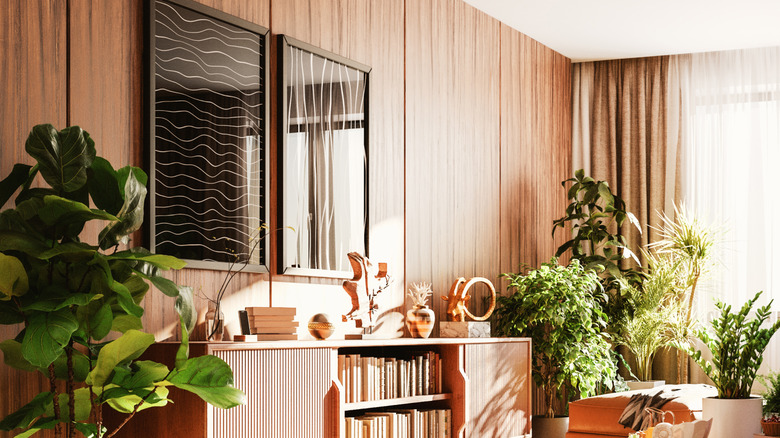The Design Hack That Makes The Most Of Short Paneling On A Feature Wall
Adding a bit of wooden paneling to your walls can completely transform the feel of your space. Depending on the style, it can either add a much-needed touch of warmth and texture to create a rustic feel or something a bit more modern. But what do you do when your paneling of choice is just a tad bit too short for your walls? There's no need to purchase a completely new set of boards. Instead, try this trick using a chair rail and different types of moldings. It works to seamlessly blend your paneling into the existing molding, essentially working to extend your baseboards by a few extra inches.
The key is achieving a cohesive, polished feel without needing to buy a custom set of panels. That's where the chair railing and molding come in, creating a visual break in your wall that mimics the feel of your existing molding. It helps to transition your newly-installed paneling into the rest of your space without worrying about a dreaded gap at the bottom of the wall. This is an especially useful project if you have some moldings lying around, leftover from another project, as you can incorporate them seamlessly into your space. Once you paint your wood paneling, your wall will suddenly transform with a rustic feel.
Achieving seamless panelling
To get started, you want to hang your paneling in the center of your wall so that there is an even gap at the top and bottom. Use a nail gun to secure it in place and for a bit of extra support, you can nail it into your wall studs. Once you're happy with the placement, it's time to start adding your trim. Place a piece of chair railing directly under your piece of paneling. Ensure that it is level before adding another sheet above it. There should be a gap between the molding at the base of your wall and your newly chair railing. Secure your railing in place with a few nails. This will help you achieve that extended baseboard feel to seamlessly transition your paneling into your wall. Directly above your panel, you want to add another piece of chair railing. Ensure that everything is level before you secure it to your wall. Grab yourself a few pieces of cove molding to place in the corner of your wall and ceiling.
You can further blend your molding and paneling into the wall using a consistent paint scheme. If your baseboards and walls are two different colors, you may opt to paint the paneling and molding the same color as the baseboards for cohesion. This helps to create dimension as well as to connect the entire room together. Don't be afraid to experiment, too, with different kinds of moldings. Creating a box molding around a small section of paneling can be a great way to create a backdrop for a piece of wall art or a wall-mounted TV.
